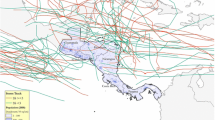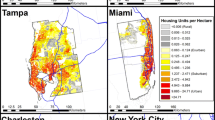Abstract
Most U.S. metropolitan regions have experienced urban “sprawl,” or the outward spreading of urban development from city centers. For cities lying in areas prone to severe weather, the sprawl phenomenon exposes greater numbers of developed areas and inhabitants to a variety of thunderstorm hazards. This study’s principal goal is to determine how urbanization growth patterns affect a region’s vulnerability to severe weather events. To assess how sprawl may impact vulnerability to tornadoes, hail, and convective wind events, an analysis examining potential loss may be utilized. This study employs two distinct approaches to examine how the Atlanta area’s rapid and extensive development during the latter half of the twentieth Century has affected its overall potential exposure to thunderstorm hazards. First, archived census data are used to estimate overall impacts from hypothetical significant tornado, nontornadic convective wind, and hail events occurring at different time periods throughout several locations in the Atlanta metropolitan region. Second, economic factors are integrated into the analysis, which assists in determining how these hypothetical severe event scenarios may have changed from a cost standpoint if they were to occur in 2006 as opposed to 1960.




Similar content being viewed by others
References
Ashley WS (2007) Spatial and temporal analysis of tornado fatalities in the United States: 1880–2005. Weather Forecast 22:1214–1228
Ashley ST, Ashley WS (2008) The storm morphology of deadly flooding events in the United States. Int J Climatol 28:493–503
Ashley WS, Gilson CW (2009) A reassessment of U.S. lightning mortality. Bull Am Meteorol Soc 90:1501–1518
Ashley WS, Mote TL (2005) Derecho Hazards in the U.S. Bull Am Meteorol Soc 86(11):1577–1592
Bentley M, Stallins T, Ashley W (2010) The Atlanta thunderstorm effect. Weatherwise 63:24–29
Blumenfeld K (2008) Convective weather hazards in the Twin Cities metropolitan area. Dissertation, University of Minnesota
Borden K, Schmidtlein M, Emrich C et al (2007) Vulnerability of U.S. cities to environmental hazards. J Homel Secur Emerg Manag 4(2):1–21
Bornstein R, LeRoy M (1990) Urban barrier effects on convective and frontal thunderstorms. Extended Abstracts, Fourth AMS conference on mesoscale processes, Boulder, CO, Am Meteor Soc
Brooks HE (2003) On the relationship of tornado path length and width to intensity. Weather Forecast 19:310–319
Brooks HE, Doswell C III, Kay M (2003) Climatological estimates of local daily tornado probability for the United States. Weather Forecast 18:626–640
Bureau of Economic Analysis (2010a) Table 1.1: Current-cost net stock of fixed assets and consumer durable goods. U.S. Department of Commerce. http://www.bea.gov/national/FA2004/SelectTable.asp. Accessed 27 July 2010
Bureau of Economic Analysis (2010b) Table 1.1.9: Implicit price deflators for gross domestic product. U.S. Department of Commerce. http://www.bea.gov/national/nipaweb/SelectTable.asp?Selected=Y. Accessed 27 July 2010
Cavin A (2003) The Reference Shelf: Urban Planning. H.W. Wilson Company, Bronx
Changnon S (1999) Impacts of hail in the U.S. In: Pielke, R (ed) Storms, 2. Routledge, pp 163–191
Changnon S (2008) Increasing major hail losses in the U.S. Clim Change 96:161–166
Changnon S, Burroughs J (2003) The Tristate hailstorm: the most costly on record. Mon Weather Rev 131:1734–1739
Changnon S, Changnon D, Fosse E et al (1997) Effects of recent extremes on the insurance industry: major implications for the atmospheric sciences. Bull Am Meteorol Soc 78:425–435
Changnon S, Pielke R, Changnon D, Sylves RT, Pulwarty R (2000) Human factors explain the increased losses from weather and climate extremes. Bull Am Meteorol Soc 81(3):437–442
Cromartie J (2001) Migrants in the rural south choose urban and natural amenities. Rural Am 15(4):7–18
Cutter S, Boruff BJ, Shirley W (2003) Social vulnerability to environmental hazards. Soc Sci Q 84:242–261
Davidson R, Lambert K (2001) Comparing the hurricane disaster risk of U.S. coastal counties. Nat Hazard Rev 2(3):132–142
Dixon P, Mote T (2003) Patterns and causes of Atlanta’s urban heat island-initiated precipitation. J Appl Meteorol 42:1273–1284
Doswell CA (2001) Severe convective storms–an overview. In: Doswell C (ed) Severe convective storms, Meteorological Monograph, 28(50). Am Meteor Soc pp 1–26
Doswell CA, Moller A, Brooks H (1999) Storm spotting and public awareness since the first tornado forecasts of 1948. Weather Forecast 14(4):544–557
Doswell CA, Brooks H, Kay M (2005) Climatological estimates of daily local nontornadic severe thunderstorm probability for the United States. Weather Forecast 20:577–595
Gillham O (2002) The limitless city: a primer on the urban sprawl debate. Island Press, Washington
Hall S, Ashley W (2008) Effects of urban sprawl on the vulnerability to a significant tornado impact in northeastern Illinois. Nat Hazard Rev 9(4):209–219
Huff F, Changnon S Jr (1973) Precipitation modification by major urban areas. Bull Am Meteorol Soc 54(12):1220–1232
Katz B, Lang R, Berube A (2005) Redefining Urban and Suburban America: Volume Two: Evidence From Census 2000. Brookings Institution Press
Metro Atlanta Chamber of Commerce (2005) Atlanta MSA growth statistics. http://www.atlantada.com/media/MSAGrowthStats2006.pdf. Accessed 17 Oct 2009
Nelson S, Rothfusz L (2009) The downtown Atlanta, Georgia, EF-2 tornado of 14 March 2008. The 89th American meteorological society annual meeting, Phoenix, AZ, Amer. Meteor. Society, P1.4
NOAA (2010) Why one inch hail criterion? http://www.weather.gov/oneinchhail/. Accessed 21 August 2010
Parker M, Knievel J (2005) Do meteorologists suppress thunderstorms? Radar-derived statistics and the behavior of moist convection. Bull Am Meteorol Soc 86(3):341–358
Pielke R Jr, Gratz J, Landsea C et al (2008) Normalized hurricane damage in the United States: 1900–2005. Nat Hazard Rev 9(1):29–42
Przybylinski R, Sieveking J, Sipprell B, Guyer J (2008) The 19 July 2006 midwest derecho: a meteorological perspective and lessons learned. The 24th conference on severe storms, Savannah, GA, Am Meteor Soc P6.4
Rygel L, O’Sullivan D, Yarnal B (2006) A method for constructing a social vulnerability index: an application to hurricane storm surges in a developed country. Mitig Adapt Strat Glob Change 11:741–764
Schneider R, Dean A, Brooks H (2009) Estimating potential severe weather societal impacts using probabilistic forecasts issued by the NWS Storm Prediction Center. 23rd conference on weather analysis and forecasting, Omaha, NE, Am Meteor Soc P5B.5
Shepherd M, Mote T, Dowd J et al (2010) An overview of synoptic and mesoscale factors contributing to the disastrous Atlanta flood of 2009. Bull Am Meteorol Soc. doi: 10.1175/2010BAMS3003.1
Smith K (2001) Environmental Hazards: assessing risk and reducing disaster, 3rd edn. Routledge, New York
Squires G (ed) (2002) Urban Sprawl: causes, consequences & policy responses. The Urban Institute Press, Washington
Sutter D, Simmons K (2010) Tornado fatalities and mobile homes in the United States. Nat Hazard 53(1):125–137. doi:10.1007/s11069-009-9416-x
Troutman T, Rose M, Trapasso L (2001) Utilizing established techniques in forecasting the potential for derecho development. http://www.srh.noaa.gov/bna/research/derecho2.htm. Accessed 27 October 2009
U.S. Census Bureau (2008) Census of population and housing. http://www.census.gov/prod/www/abs/decennial/index.htm. Accessed 22 August 2010
U.S. Census Bureau (2009) Vintage 2006 archive. http://www.census.gov/popest/archives/2000s/vintage_2006/. Accessed 22 August 2010
World Almanac (2008) The World Almanac and book of facts. U.S. cities, states and population. World Almanac, New York 1008 pp
Author information
Authors and Affiliations
Corresponding author
Rights and permissions
About this article
Cite this article
Paulikas, M.J., Ashley, W.S. Thunderstorm Hazard vulnerability for the Atlanta, Georgia metropolitan region. Nat Hazards 58, 1077–1092 (2011). https://doi.org/10.1007/s11069-010-9712-5
Received:
Accepted:
Published:
Issue Date:
DOI: https://doi.org/10.1007/s11069-010-9712-5




